child seat AUDI A5 CABRIOLET 2013 Owner's Manual
[x] Cancel search | Manufacturer: AUDI, Model Year: 2013, Model line: A5 CABRIOLET, Model: AUDI A5 CABRIOLET 2013Pages: 290, PDF Size: 72.35 MB
Page 151 of 290
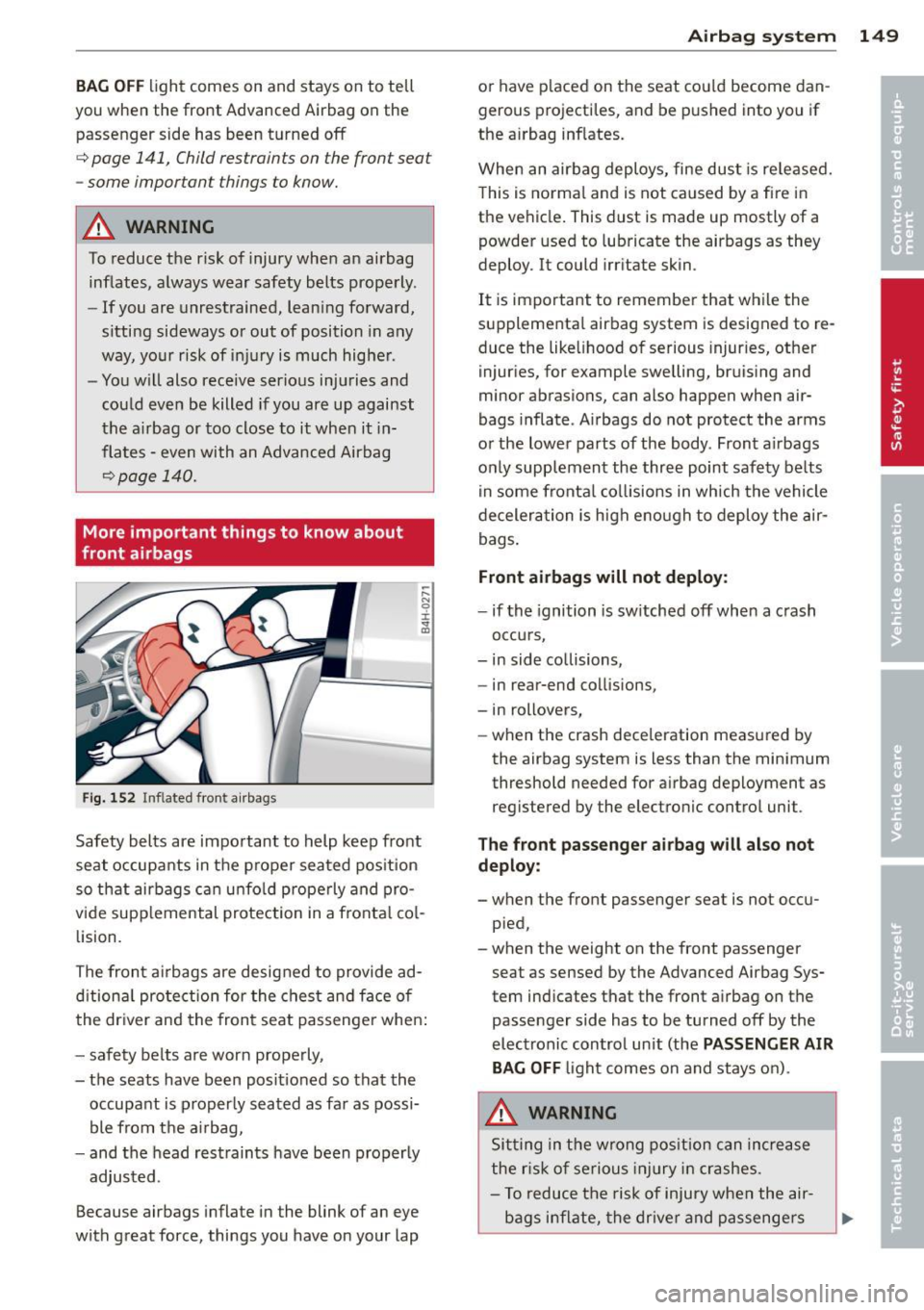
BAG OFF light comes on and stays on to tell
you when the front Advanced Airbag on the
passenger side has been turned
off
c:> page 141, Child restraints on the front seat
- some important things to know.
A WARNING
To reduce the risk of injury whe n an airbag
inflates, always wear safety belts properly .
- If you are unrestrained, lean ing forward,
sitting sideways or out of position in any
way, yo ur risk of injury is much higher.
- You w ill also receive serious injuries and
could even be killed if you are up against
the a irbag or too close to it when it in·
flates · even with an Advanced Airbag
c:>page 140.
More important things to know about
front airbags
Fi g. 152 Inflated front a irbags
Safety belts are important to help keep front
seat occupants in the proper seated pos ition
so that airbags c an u nfo ld properly and pro
vide supp lemental protection in a fronta l co l
lision.
The front a irbags are designed to provide ad
d itiona l protection for the chest and face of
the dr iver and the front seat passenge r when:
- safety belts are worn properly,
- the seats have been posit io ned so that the
occupant is p roperly seated as far as possi
ble from the a irbag,
- and the head restraints have been properly
adjusted.
Because airbags inflate in the blink of an eye
with great force, things you have on your lap
A irba g sy stem 149
or have p laced on the seat co uld become dan
gerous projectiles, and be p ushed into you if
the a irbag inf lates.
When an airbag deploys, fine dust is re leased.
T his is norma l and is not caused by a fi re in
the ve hicle . This dust is made up mostly of a
powder used to lubricate the airbags as they
deploy. It could irr itate skin .
It is important to remembe r that wh ile the
supplementa l airbag system is designed to re
duce the like lihood of serious injur ies, other
injuries, for example swelling, bruis ing and
minor abrasions, can also happen when air
bags inflate . A irbags do not protect the arms
o r the lower parts of the body. Front a irbags
on ly supp lement the three point safety belts
in some fronta l colli sions in which the vehicle
decelera tion is high e no ugh to deploy the air
bags .
Front airbags will not deploy :
-if the ignition is sw itched off when a crash
occu rs,
- in side collisions,
- in rear-end collisions,
- in rollovers,
- when the crash deceleration measured by
the airbag system is less than the minimum
threshold needed for a irbag deployment as
reg istered by the electronic contro l unit .
The front pa sse nge r airbag will also not
deploy:
- when the front passenger seat is not occu
pied,
- when the weight on the front passenger seat as sensed by the Advanced Airbag Sys·
tern ind icates that the front airbag on the
passe nger side has to be turned off by the
electronic control unit (the
PASSENGER A IR
BAG OFF
li ght comes on and stays on) .
A WARNING
Sitting in the wrong position can increa se
the r is k of se rious inj ury in crashes.
- To reduce the risk of injury when the air
bags inflate, the drive r and passenge rs
Page 152 of 290
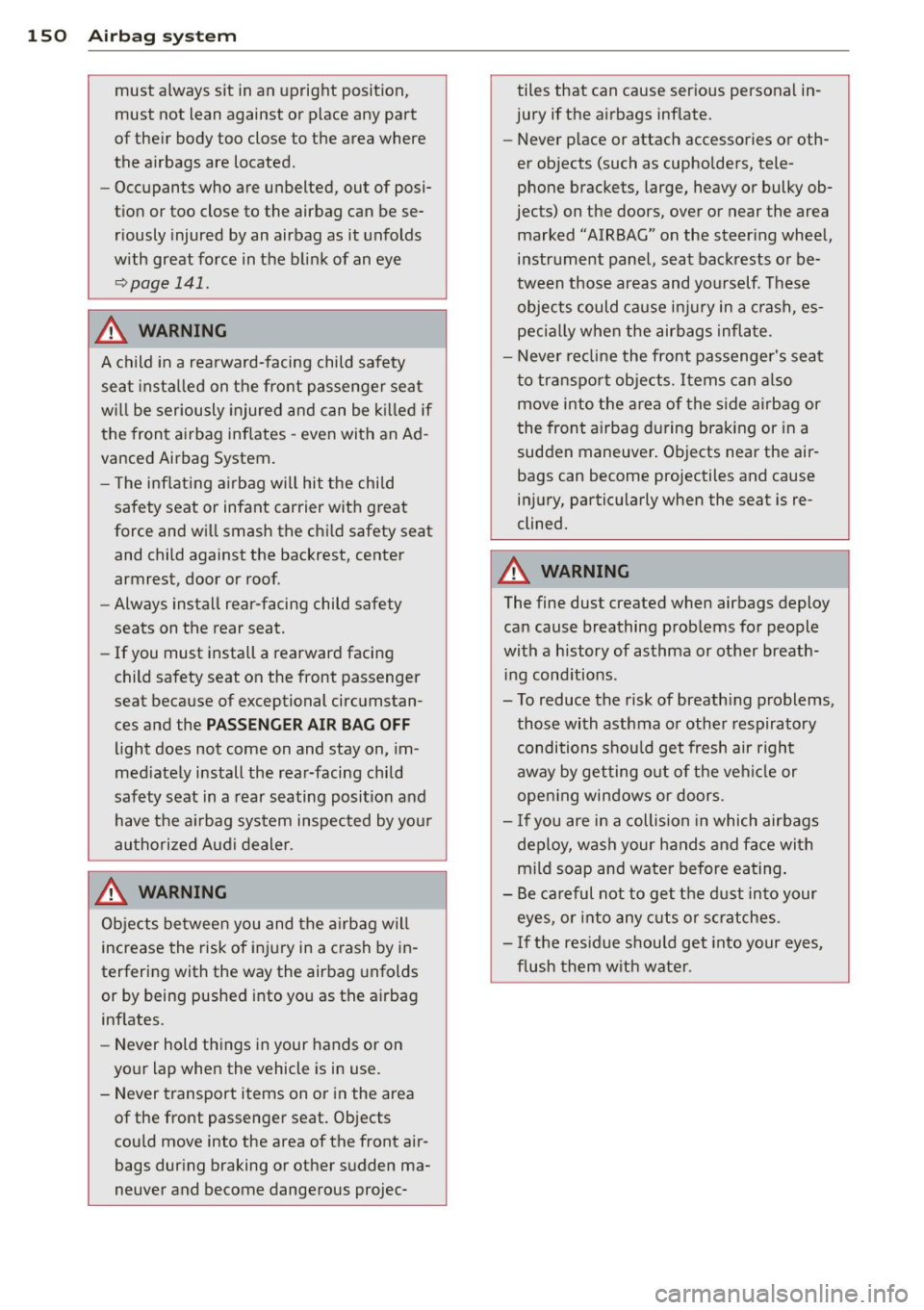
150 Airbag system
must always sit in an upright position,
must not lean against or place any part
of their body too close to the area where
the airbags are located .
- Occupants who are unbelted, out of posi
tion or too close to the airbag can be se riously injured by an airbag as it unfolds
with great force in the blink of an eye
~page 141.
A WARNING
A child in a rearward-facing child safety
seat installed on the front passenger seat
will be seriously injured and can be killed if
the front airbag inflates -even with an Ad
vanced Airbag System.
- The inflating airbag will hit the child
safety seat or infant carrier with great
force and will smash the child safety seat
and child against the backrest, center
armrest, door or roof.
- Always install rear-facing child safety
seats on the rear seat.
- If you must install a rearward facing
child safety seat on the front passenger
seat because of exceptional circumstan
ces and the
PASSENGER AIR BAG OFF
light does not come on and stay on, im
mediately install the rear-facing child
safety seat in a rear seating position and
have the airbag system inspected by your
authorized Audi dealer.
A WARNING
Objects between you and the airbag will
increase the risk of injury in a crash by in
terfering with the way the airbag unfolds
or by being pushed into you as the airbag
inflates.
- Never hold things in your hands or on
your lap when the vehicle is in use.
- Never transport items on or in the area of the front passenger seat. Objects
could move into the area of the front air
bags during braking or other sudden ma
neuver and become dangerous projec- tiles that can cause serious personal in
jury if the airbags inflate.
- Never place or attach accessories or oth
er objects (such as cupholders, tele phone brackets, large, heavy or bulky ob
jects) on the doors, over or near the area marked "AIRBAG" on the steering wheel,
instrument panel, seat backrests or be
tween those areas and yourself. These
objects could cause injury in a crash, es
pecially when the airbags inflate.
- Never recline the front passenger's seat
to transport objects. Items can also
move into the area of the side airbag or
the front airbag during braking or in a
sudden maneuver. Objects near the air
bags can become projectiles and cause
injury, particularly when the seat is re
clined.
A WARNING
'-
The fine dust created when airbags deploy
can cause breathing problems for people
with a history of asthma or other breath
ing conditions.
- To reduce the risk of breathing problems, those with asthma or other respiratory
conditions should get fresh air right
away by getting out of the vehicle or
opening windows or doors.
- If you are in a collision in which airbags
deploy, wash your hands and face with
mild soap and water before eating.
- Be careful not to get the dust into your
eyes, or into any cuts or scratches.
- If the residue should get into your eyes,
flush them with water.
Page 153 of 290
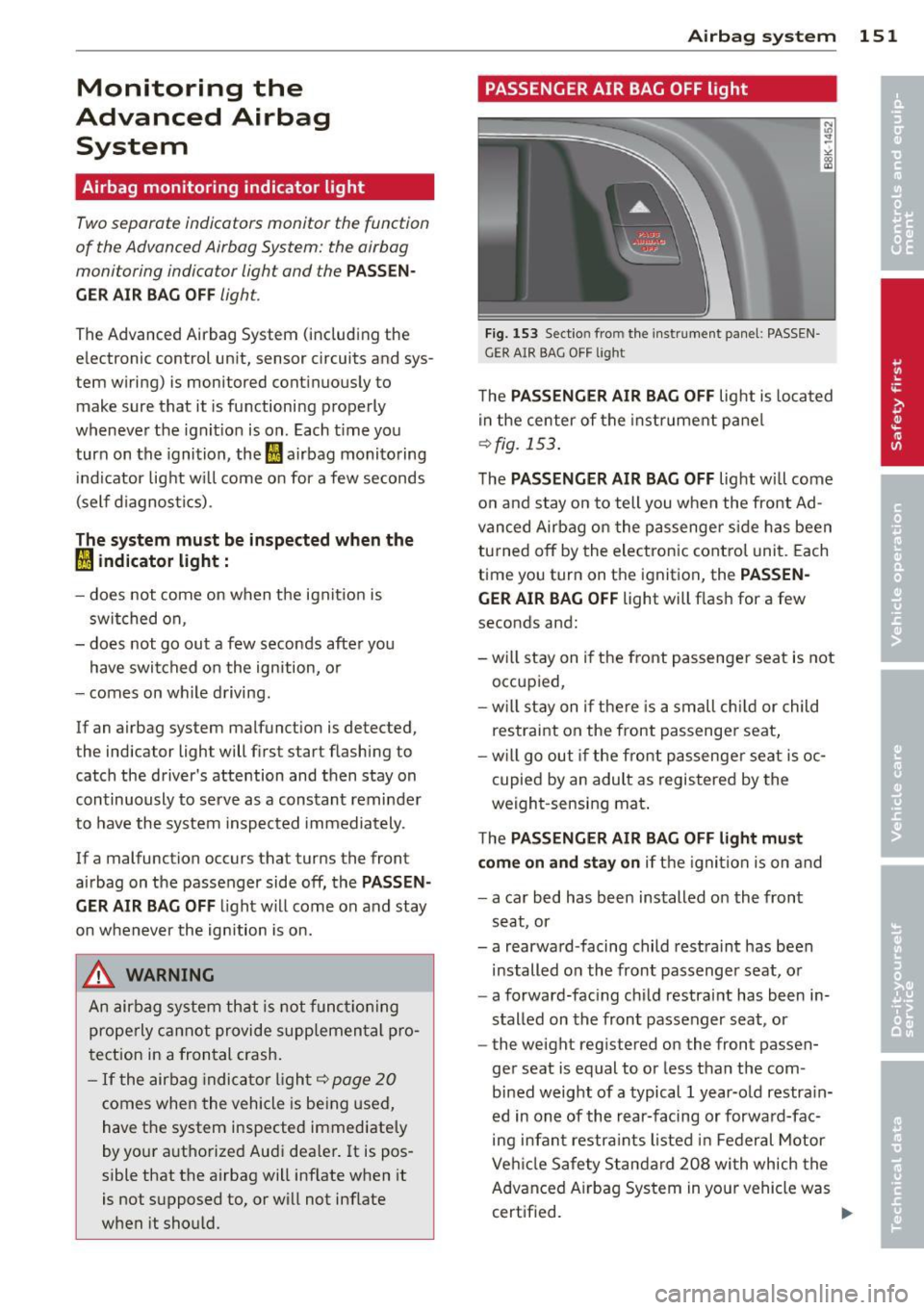
Monitoring the
Advanced Airbag
System
Airbag monitoring indicator light
Two separate indicators monitor the function
of the Advanced Airbag System: the airbag
monitoring indicator light and the
PAS SEN
G ER AIR B AG
OFF light.
The Advanced Airbag System (including the
e lectronic control unit, sensor circuits and sys
tem wiring) is monitored continuously to
make sure that it is functioning properly
whenever the ignit ion is on . Each t ime you
turn on the ignition, the
I airbag monitoring
i ndicator light w ill come on for a few seconds
(self diagnostics) .
The system mu st be in spected when the
I indicator l ight:
- does not come on when the ignit ion is
switched on,
- does not go out a few seconds after yo u
have switched on the ignition, o r
- comes on while driving .
If an airbag system malfunction is detected,
the indicator light will first start flashing to
catch the driver's attention and then stay on
continuously to serve as a constant reminder
to have the system inspected immediately.
If a malfunction occurs that turns the front
airbag on the passenger side off, the
PASSEN
GER AIR BAG
OFF li ght will come on and stay
on whenever the ignition is on.
_& WARNING
An airbag system that is not funct ioning
properly cannot provide supp lemen tal p ro
tection in a frontal crash.
- If the airbag indicator l ight c::> page 20
comes when the vehicle is be ing used,
have the system inspected immediately
by your authorized Audi dea ler .
It is pos
sible that the airbag will inflate when it is not supposed to, or w ill not inflate
when it should.
-
A irba g sy stem 151
PASSENGER AIR BAG OFF light
Fig. 153 Sect io n fro m the instrument panel: PASSEN
GER AIR BAG OFF light
The PAS SENG ER AIR BAG OFF light is located
in the center of the instrument pa ne l
¢ fig. 153 .
The PAS SENG ER AIR BA G OFF light will come
on and stay on to tell you when the front Ad
vanced Airbag on the passenger s ide has been
tu rned off by the electronic cont rol unit. Each
time you turn on the ignition, the
PASSEN
GE R AIR BA G OFF
light will flash for a few
seconds and:
- wi ll stay on if the front passenger seat is not
occupied,
-w il l stay on if there is a small ch ild or child
restraint on the front passenger seat,
- w ill go out if the front passenger seat is oc
cupied by an adult as registered by the
weight-sensing mat .
The
PAS SEN GER AIR BAG OFF li ght mu st
co m e on and st ay o n if the ignition is on and
- a car bed has been installed on the front
seat, or
- a rearward -facing child restraint has been
installed o n the front passenger seat, or
- a forward-fac ing child restraint has been in
stalled on the front passenger seat , or
- the weight registered on the front passen
ger seat is equal to or less than the com
bined weight of a typical 1 year-old restra in
ed in one of the rear-facing or forward-fac
ing infan t restra ints listed in Federal Motor
Veh icle Safety Standard 208 wi th which the
Advanced A irbag System in your vehicle was
certified.
111-
Page 154 of 290
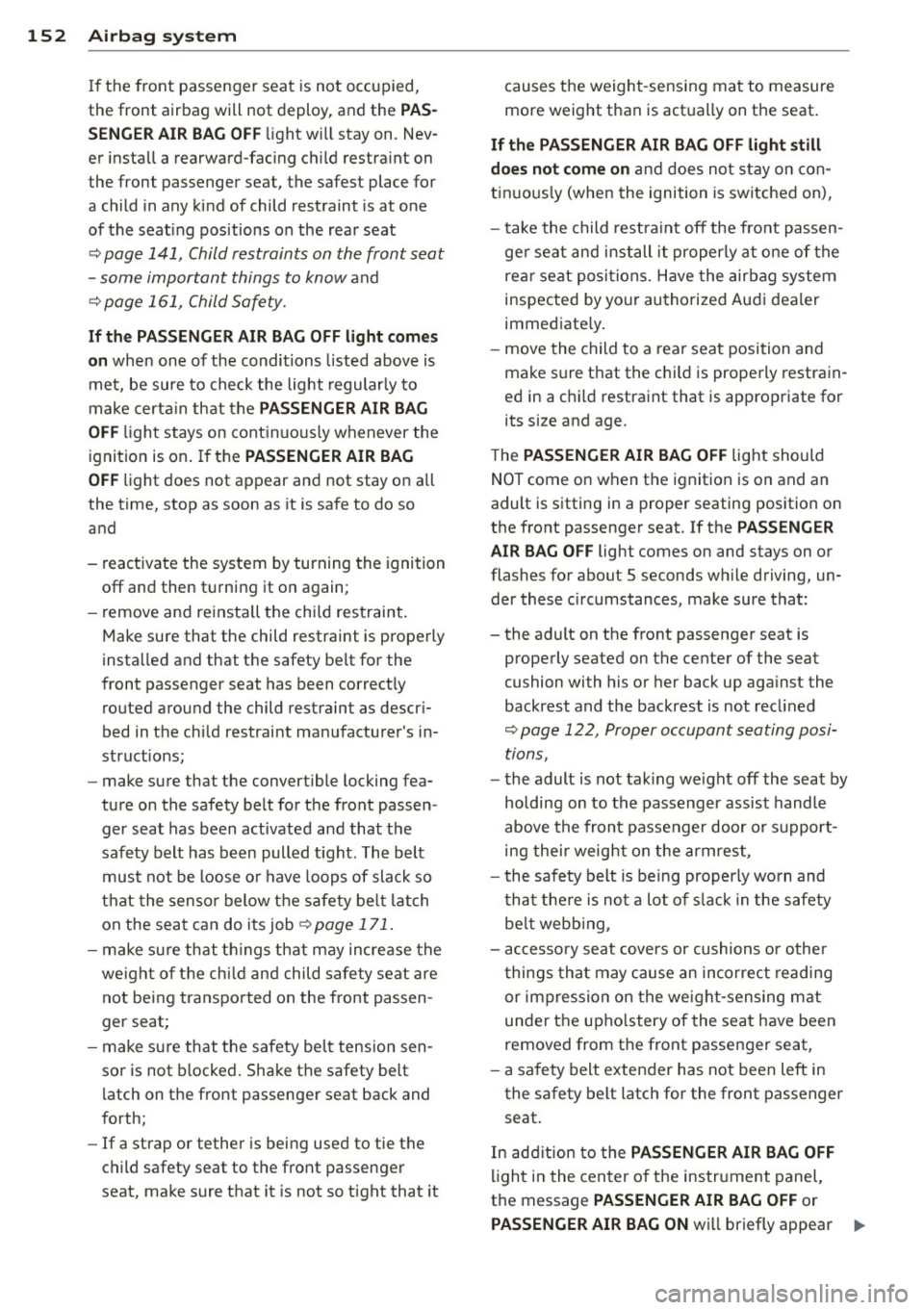
152 Airbag sys te m
If the front passenger seat is not occupied,
the front airbag will not deploy, and the
PAS
SENGER AIR BAG OF F
light wi ll stay on. Nev
er install a rearward-fac ing ch ild restra int on
the front passenger seat, the safest place fo r
a child in any kind of child restraint is at one
of the seat ing positions on the rear seat
¢ page 141, Child restraints on the front seat
- some important things to know
and
¢ page 161, Child Safety.
If th e PASSEN GER AI R BAG OFF light c ome s
on
when one of the conditions listed above is
met, be sure to check the light regular ly to
make certa in that the
PAS SENGER AIR BA G
O FF
light stays on cont inuous ly whenever the
ignition is on. If the
PASSENGER AIR BAG
OFF
li ght does not appear and not stay on all
the time, stop as soon as it is safe to do so
and
- reactivate the system by turning the ignition off and then turning it on again;
- remove and re install the child restraint.
Make sure that the child restraint is properly
installed and that the safety be lt for the
front passenger seat has been correctly routed around the child restraint as descr i
bed in the child restraint manufacturer's i n
structions;
- make sure that the convertible locking fea
ture on the safety belt for the front passen
ger seat has been activated and that the
safety belt has been pulled tight. The belt
mus t not be loose o r have loops of slack so
that the senso r below the safety be lt latch
on the seat can do its job¢
page 171 .
-make su re that th ings that may increase the
weight of the ch ild and child safety seat are
not being transpo rted on the front passen
ger seat;
- make su re that the safety belt tension sen
sor is not b locked. Shake the safety be lt
l atch on the front passenger seat back and
forth;
- If a strap or tether is being used to tie the
child safety seat to the front passenger
seat, make sure that it is not so tight that it causes the weight
-sensing mat to measure
more weight than is act ually on the seat.
If th e PASSENGER AIR BAG OFF light still
does not come on
and does not s tay on con
t in uous ly (when the ignition is switched on) ,
- take the child restraint off the front passen-
ge r seat and install it properly at one of the
rea r seat posi tions. H ave the airbag system
inspected by yo ur authorized Audi dealer
immediate ly .
- move the child to a rear seat position and
make sure t hat the c hild is properly restrain
ed in a c hild restraint that is appropriate for
its size and age.
T he
PAS SENGER AIR BAG OFF light should
NOT come on when t he ignition is on and an
adult is sitting in a proper seating position on
the front passenger seat. If the
PASSENGER
AIR BAG OFF
light comes on and stays on or
flashes for about 5 seconds wh ile driving, un
der these c ircumstances, make sure that:
- the adult on the front passenger seat is properly seated on the center of the seat
cushion with his or her back up aga inst the
backrest and the backrest is not recl ined
¢ page 122, Proper occupant seating posi
tions,
- the adult is not tak ing weight off the seat by
holding on to the passenger assist handle
above the fron t passenger door or support
ing their weight on the armrest,
- the safety belt is being properly wo rn and
t ha t the re is no t a lot of s lack in the safety
be lt webb ing ,
- accesso ry seat covers or cushions or other
t hings tha t may cause an incorrect reading
or impression on the weight-sensing mat
under the upho lstery of the seat have been
removed from the front passenger seat,
- a safety belt extender has not been left in
the safety belt latch for the front passenger
seat.
In add ition to the
PASSENGER AIR BAG OFF
light in the center o f the instrument panel,
t h e message
PASSENGER AIR BAG OFF or
PASSENGER AIR BAG ON wi ll briefly appear ..,.
Page 155 of 290
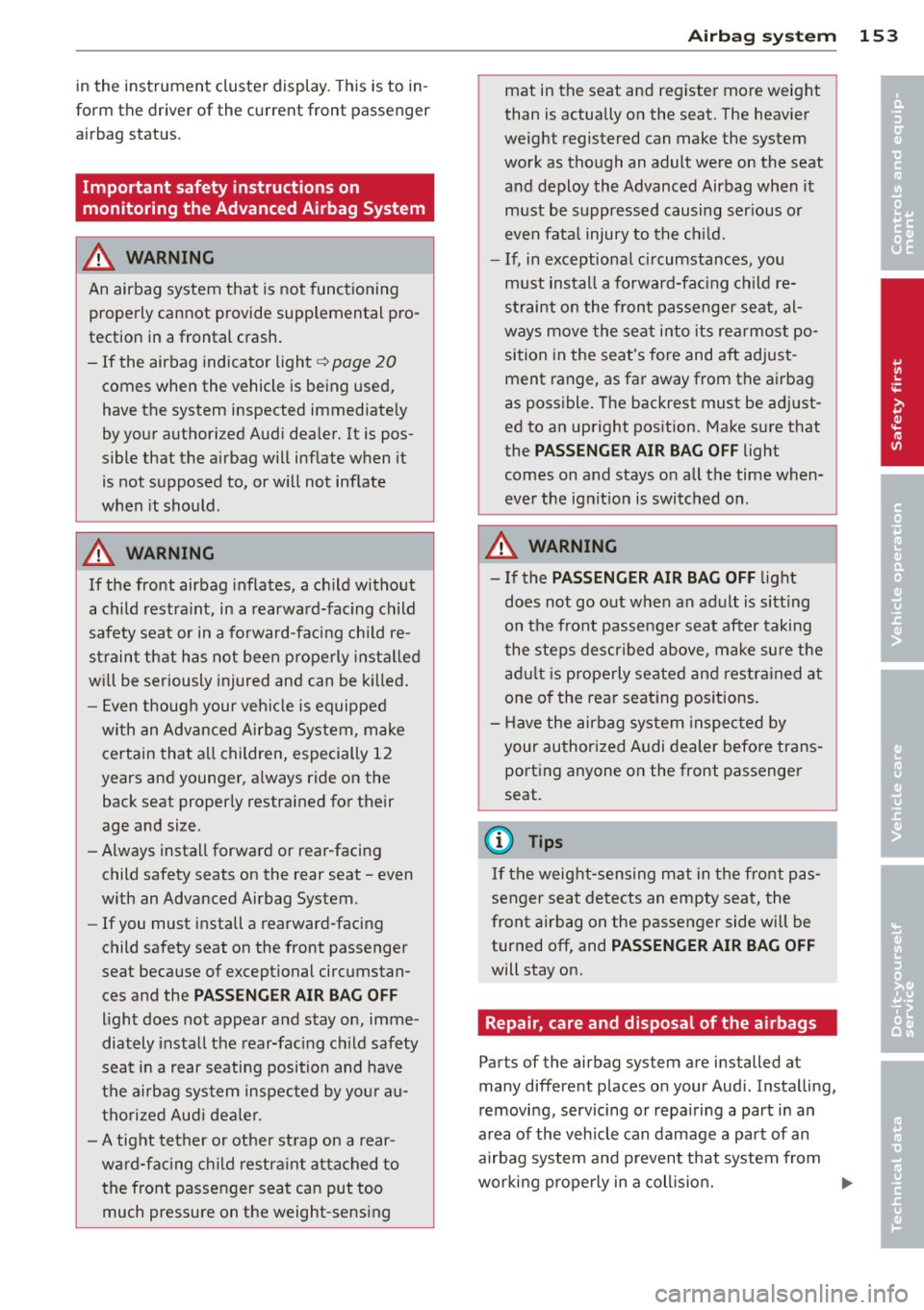
in the instrument cluster display. This is to in
form the driver of the current front passenger
airbag status.
Important safety instructions on
monitoring the Advanced Airbag System
A WARNING t a=
An airbag system that is not functioning
properly cannot provide supplemental p ro
tection in a frontal crash .
- If the airbag indicator light¢
page 20
comes when the vehicle is be ing used,
have the system inspected immediately
by your authorized Aud i dea ler. It is pos
sible that the a irbag will inflate when it
is not supposed to, or w ill not inflate
when it sho uld.
A WARNING
If the front airbag inflates, a ch ild without
a child restra int, in a rearwa rd-facing child
safety seat or in a forward-facing chi ld re
st raint th at has not been properly insta lled
w ill be seriously injured and can be k illed .
- Even though your veh icle is equipped
with an Advanced Airbag System, make certain that a ll children, especially 12
years and younger, a lways ride on the
back seat properly restrained for their
age and size.
- Always install forward or rea r-facing
child safety seats on the rear seat -even
with an Advanced Airbag System.
- If you must install a rearward-facing
child safety seat on the front passenger
seat because of exceptional circ umstan
ces and the
PASSENGER AIR BAG OFF
light does not appear and s tay on , imme
diately install the rear-fac ing ch ild safety
seat i n a rear seating position and have
the a irbag system inspected by yo ur au
thori ze d Au di dea ler.
- A tig ht tether or other st rap on a rear
wa rd-fa cing child res trai nt at ta che d to
the front passenger sea t can put too
much pressure on the weight -sens ing
-
A irbag system 153
mat in the seat and reg ister more weight
than is actually on the seat. The heavier
weight registered can make the system
work as though an adult were on the seat and deploy the Advanced Airbag when it
must be suppressed causing ser ious or
even fata l injury to the ch ild.
- If, in exceptiona l circumstances, you
must install a forward-fac ing ch ild re
s traint o n the front pas senger seat, al
ways move the sea t into its re armos t po
sition in the seat's fore and aft adjust
ment range, as far away from the a irbag
as poss ible . The backrest must be ad just
ed to an upright pos ition. Make sure that
the
PASSENGER AIR BAG OFF light
comes on and stays on all the time when
eve r the ignit ion is switched on.
A WARNING
- If the PASSENGER AIR BAG OFF light
does not go out when an a dult is sitting
on t he front passe nger sea t after taking
the steps described above, make su re the
ad ult is prope rly seated and restr ained at
one o f the rea r seat ing pos itions.
- Have the airbag system inspe cted by
your author ized Audi dealer befo re trans
port ing anyone on the front passenger
seat.
(D Tips
If t h e weight-sensing mat in the front p as
senger seat detects an empty sea t, the
front airbag on the passenger side wi ll be
turned off, and
PASSENGER AIR BAG OFF
will stay on.
Repair , care and disposal of the airbags
Parts of the airbag system are installed at
many different places o n your Aud i. Insta lling,
removi ng, servicing or repa iring a par t in an
ar ea of the veh icle can damage a part of an
a irbag system and p reven t that system from
wor kin g p ro perly in a coll is io n. .,,.
•
•
Page 159 of 290
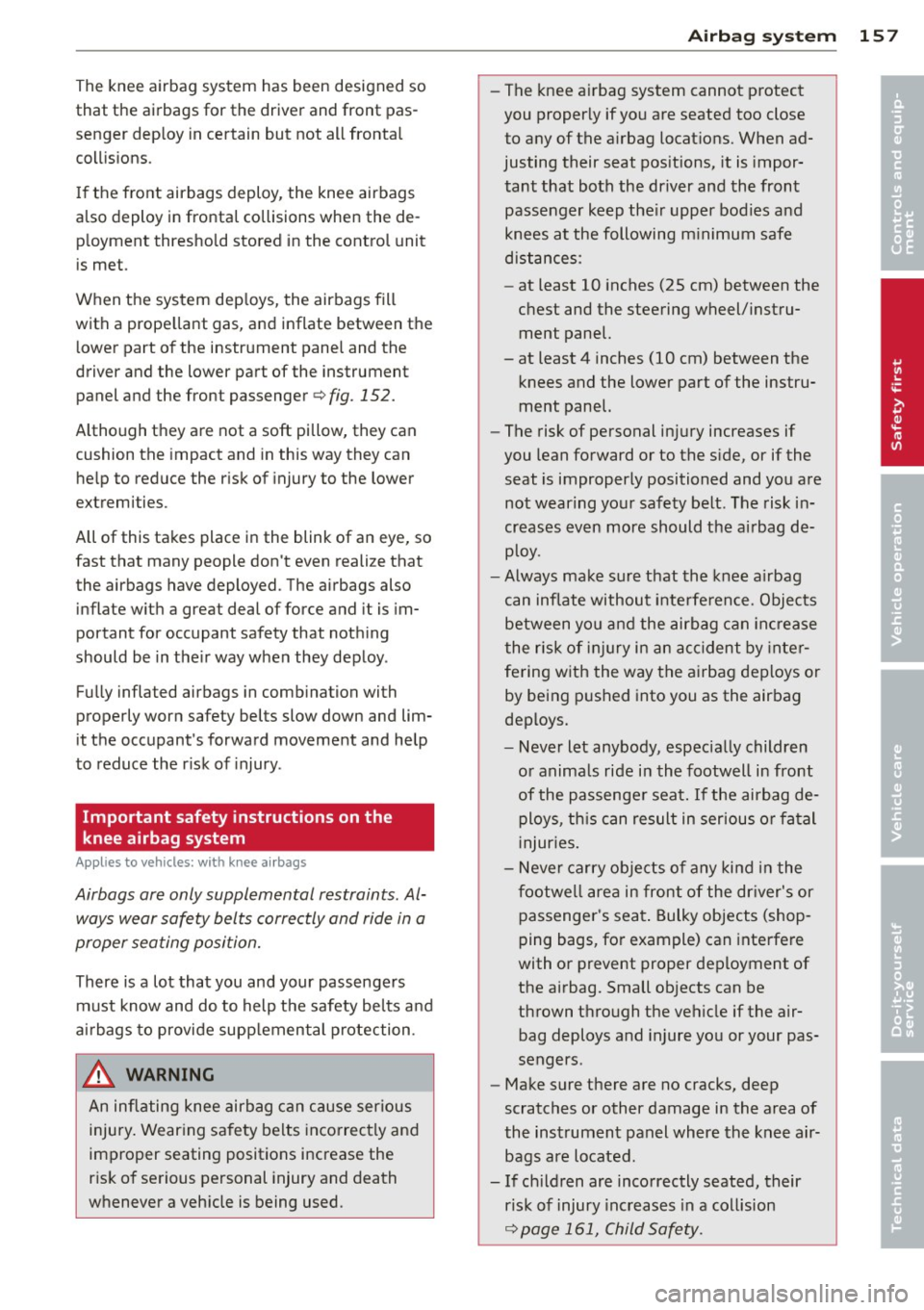
The knee airbag system has been designed so
that the airbags for the driver and front pas
senger deploy in certain but not all frontal
collis ions.
I f the front airbags deploy, the knee airbags
also deploy in fronta l collisions when the de
p loyment threshold stored in the control unit
is met.
When the system dep loys, the airbags fill
with a prope llant gas, and inflate between the
l ower part of the instrument panel and the
driver and the lower part of the instrument panel and the front passenger
c> fig. 152.
Although they are not a soft pillow, they can
cushion the impact and in this way they can
he lp to reduce the r isk of injury to the lower
extremities.
All of this takes place in the blink of an eye, so
fast that many people don 't even realize that
the airbags have deployed. The airbags also inflate w ith a great deal of force and it is im
portant for occupant safety that noth ing
should be in the ir way when they deploy .
Fu lly inflated airbags in comb ination with
properly worn safety belts slow down and lim
it the occupant's forward movement and help
to reduce the r isk of injury.
Important safety instructions on the
knee airbag system
A ppl ies to vehicles: with knee a irbags
Airbags are only supplemental restraints. Al
ways wear safety belts correctly and ride in a
proper seating position.
There is a lot that you and your passengers must know and do to help t he safety belts and
ai rbags to provide supp lemental p rotection .
_& WARNING
An inflating knee airbag can c ause ser ious
injury. Wear ing safety belts inco rrectly and
improper seating positions increase the
ris k of se rious personal injury and death
whenever a veh icle is being used.
A irbag system 157
-The knee a irbag system cannot p rotect
you proper ly if you a re seated too close
to any of the a irbag locat ions. When ad
justing their seat pos itions, it is impor
tant that both the driver and the front passenger keep the ir upper bod ies and
knees at the following m inimum safe
dist ances:
- at least 10 inches (25 cm) between the
chest and the steering wheel/instru
ment panel.
- at least 4 inches (10 cm) between the knees and the lower part of the instru
ment panel.
- The risk of personal in jury increases if
you lean forward or to the s ide, or if the
seat is improperly positioned and you are
not wearing yo ur safety belt . The risk i n
creases even more should the ai rbag de
ploy.
- Always ma ke sure that the knee a irbag
can inflate without inte rfe rence. Objects
between yo u and the airbag can inc rease
the risk of in jury in an acc ident by inte r
fering w ith the way the a irbag deploys or
by being p ushed into you as the airbag
deploys.
- Never let anybody, especia lly children
or anima ls ride in the footwell in front
of the passenge r seat. If the airbag de
ploys, th is can result in serious or fa tal
i njur ies.
- Never carry obje cts of any kind in the
footwe ll area in front of the dr iver' s or
passenger 's sea t. Bulky objects (shop
ping bags, fo r example) can interfere
with o r prevent proper deployment of
the airbag. Small objects can be
thrown through the ve hicle if the air
bag deploys and injure you or your pas
sengers.
- Make sure there are no cracks, deep
scratches or other damage in the area of
the instrument panel where the knee air
bags are located.
- If ch ildren are incorrectly seated, their
risk of injury increases in a collision
c> page 161, Child Safety.
•
•
Page 161 of 290
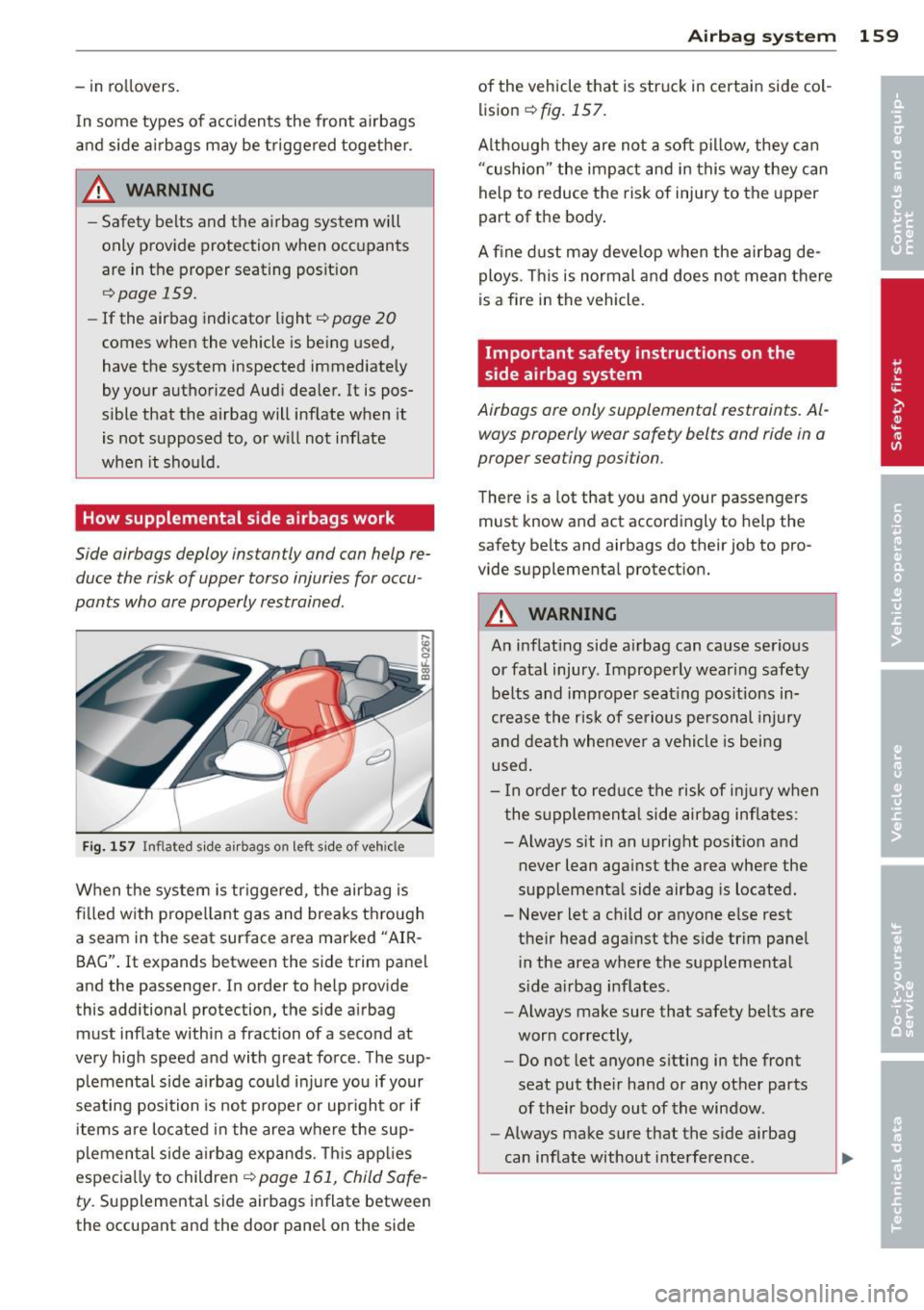
- in rollovers.
I n some types of acc idents the front airbags
and side ai rbags may be t rigge red togethe r.
A WARNING
- Safety belts and t he a irbag sys tem will
only provide protection when occupan ts
are in the p roper seating posit ion
¢ page 159.
-If the airbag indicato r light c::> page 20
comes when the vehicle is be ing used,
have the system inspected immediately
by your authori zed Aud i dea ler. It is pos
sible that the airbag will inflate when it
is not supposed to, or w ill not inflate
when it sho uld .
How supplemental side airbags work
.
Side airbags deploy ins tan tly and can help re
duce the risk of upper torso injuries for occu
pants who are properly restrained .
Fig. 15 7 Infla ted s ide a irbag s on left s ide of ve hicle
When the system is trigge red , the airbag is
fi lled w ith p ropel lant gas and breaks thro ugh
a seam in the seat surface area marked "AIR
BAG" . It expands between the side trim panel
and the passenger. In orde r to help provide
t his additional protection, the side a irbag
must inf late within a fraction of a second at
very high speed a nd with great force . The sup
p lemental side a irbag could injure you if your
seating position is not p roper or upr ight or if
items are located in the area where the sup
p lemental side a irbag expands . T his app lies
especia lly to children
c::> page 161, Child Safe
ty.
Supplemental side airbags inflate between
the occupant and the door pane l on the side
A irba g sy stem 159
of the vehicle that is struck in certain side col
lision
c::> fig . 157 .
Although they are no t a soft pillow , they can
"cushion" the impa ct and in this way they can
help to reduce the risk of injury to the upper
part of the body .
A fine dust may develop when the airbag de
ploys . T his is normal and does no t mean there
is a fire in the vehicle.
Important safety instructions on the
side airbag system
Airbags are only supplemental restraints . Al
ways properly wear safety belts and r ide in a
proper sea ting position.
T here is a lot that you and your passengers
must know and act accord ingly to help the
safety belts and airbags do the ir job to pro
vide supplemental protect ion.
A WARNING ,-
An inflat ing s ide a irbag can cause se rious
or fata l injury . Improperly wearing safety
belts and imp roper seat ing pos itions in
crease the risk of serious pe rsonal injury
and death whenever a vehicle is being
used.
- I n o rder to red uce the risk of i nju ry when
the s upplemental side airbag inflates:
- Always sit in an upright position and never lean against the area where the
suppleme nta l side airbag is located.
- Never let a child or anyone e lse rest
their head aga inst the s ide trim pane l
i n the area where the supplementa l
s ide a irbag inflates .
- Always make sure that safety belts are
worn correctly,
- Do not let anyone s itting in the front
seat put t he ir hand or any ot her parts
of their body out of the window .
- Always make su re t hat the side a irbag
can inflate without interfe rence .
Page 162 of 290
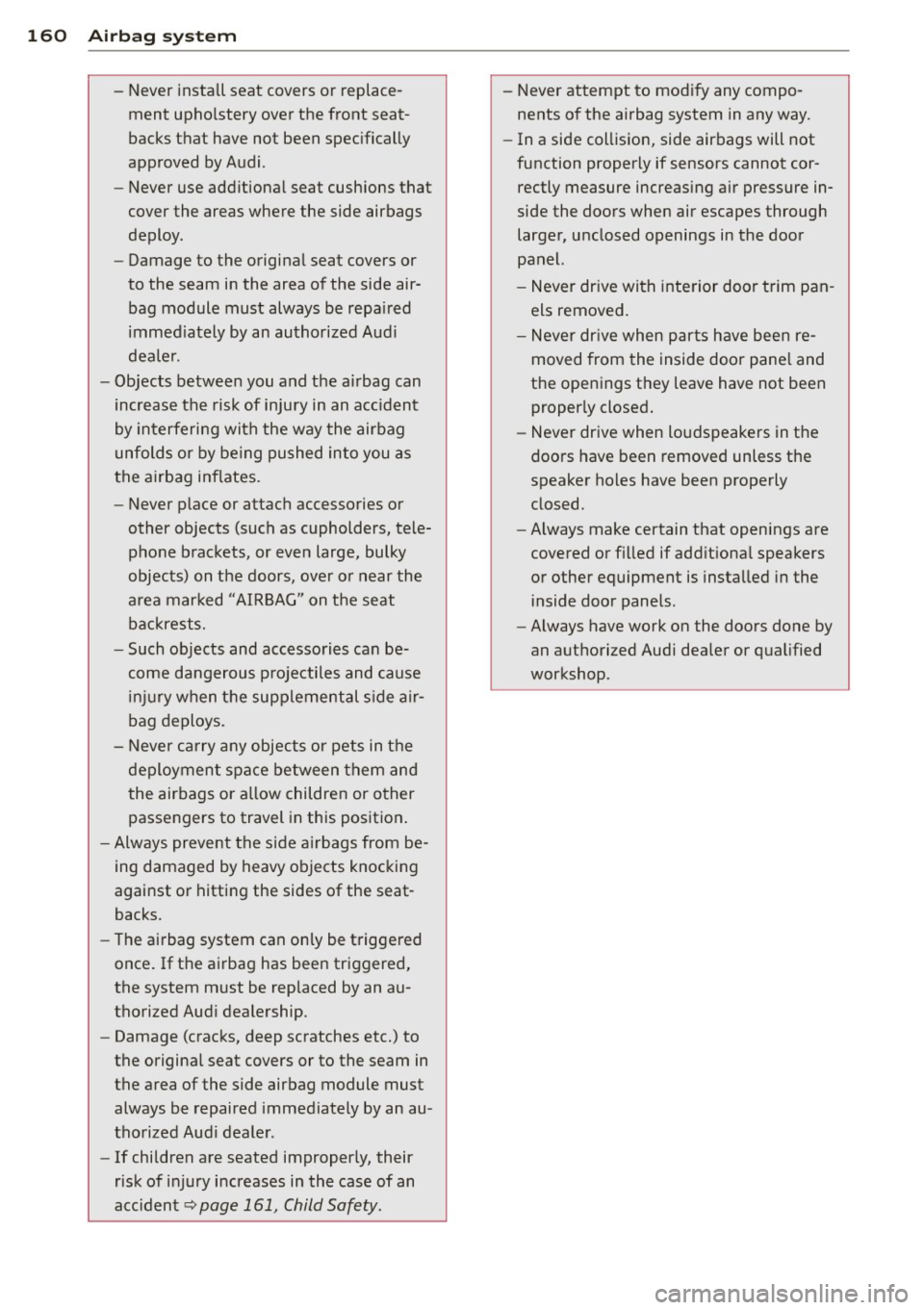
160 Airbag system
-Never install seat covers or replace
ment upholstery over the front seat
backs that have not been specifically
approved by Audi.
- Never use additional seat cushions that
cover the areas where the side airbags
deploy.
- Damage to the original seat covers or
to the seam in the area of the side air bag module must always be repaired
immediately by an authorized Audi
dealer .
- Objects between you and the airbag can
increase the risk of injury in an accident
by interfering with the way the airbag
unfolds or by being pushed into you as
the airbag inflates.
- Never place or attach accessories or
other objects (such as cupholders, tele phone brackets, or even large, bulky
objects) on the doors, over or near the
area marked "AIRBAG" on the seat backrests.
- Such objects and accessories can be
come dangerous projectiles and cause
injury when the supplemental side air
bag deploys.
- Never carry any objects or pets in the
deployment space between them and
the airbags or allow children or other
passengers to travel in this position.
- Always prevent the side airbags from be
ing damaged by heavy objects knocking
against or hitting the sides of the seat
backs.
- The airbag system can only be triggered
once.
If the airbag has been triggered,
the system must be replaced by an au
thorized Audi dealership.
- Damage (cracks, deep scratches etc.) to
the original seat covers or to the seam in
the area of the side airbag module must always be repaired immediately by an au
thorized Audi dealer .
- If children are seated improperly, their
risk of injury increases in the case of an
accident ~
page 161, Child Safety.
-Never attempt to modify any compo
nents of the airbag system in any way .
- In a side collision, side airbags will not
function properly if sensors cannot cor
rectly measure increasing air pressure in
side the doors when air escapes through larger, unclosed openings in the door
panel.
- Never drive with interior door trim pan
els removed.
- Never drive when parts have been re
moved from the inside door panel and
the openings they leave have not been properly closed.
- Never drive when loudspeakers in the
doors have been removed unless the
speaker holes have been properly
closed.
- Always make certain that openings are
covered or filled if additional speakers
or other equipment is installed in the
inside door panels.
- Always have work on the doors done by
an authorized Audi dealer or qualified
workshop.
Page 163 of 290
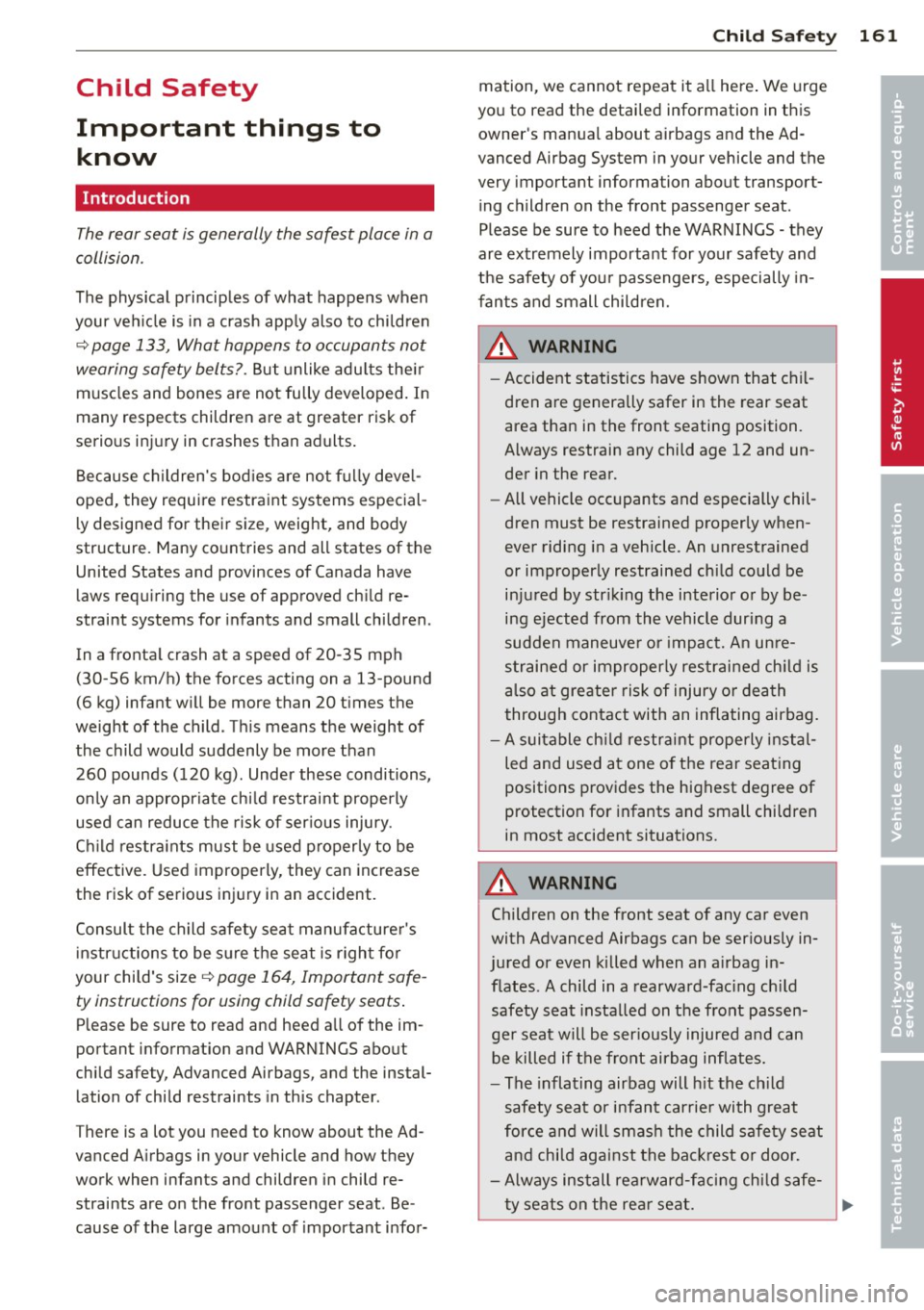
Child Safety
Important things to know
Introduction
The rear seat is generally the safest place in a
collision .
The physical principles of what happens when
your veh icle is in a crash app ly also to chi ldren
q page 133, What happens to occupants not
wearing safety belts? .
But unlike adu lts thei r
muscles and bones are not fully developed. In
many respects children are at greater risk of
serio us inju ry in crashes than adults .
Because children's bod ies are not fu lly deve l
oped, they require restraint systems especial
l y des igned for their size, weight, and body
structure. Many co untries and all states of th e
United States and p rovinces of Canada have
laws requ iring the u se of approved ch ild re
straint systems for infants and small children .
In a frontal crash at a speed o f 20 -35 mph
(30-56 km/h) the forces acting on a 13-po und
(6 kg) infant w ill be more than 20 t imes the
weight of the child . Th is means the weight of
the child would suddenly be more than
260 pounds ( 120 kg). Under these conditions,
on ly an appropriate chi ld restrai nt properly
used can reduce the risk of ser ious injury.
Ch ild restr aints must be used p roperly to be
effective. Used improperly, they can inc rease
the risk of serious in jury i n an accident.
Consult the chil d safety seat manufacture r's
i nstr uctions to be s ure the seat is r igh t for
your chi ld's size
q page 164, Important safe
ty instructions for using child safety seats .
Please be sure to read and heed a ll of the im
portant informat ion and WARNINGS abo ut
child safety, Advanced Airbags, and the ins tal
lation of child restraints in this chapter.
T here is a lot you need to know about the Ad
vanced A irbags in your vehicle and how they
work when infants and children in child re
straints are on the front passenger seat . Be
cause of the large amount of important i nfor-
Child Sa fet y 161
mation, we cannot repeat it a ll here . We urge
you to read the detai led information in this
owner 's man ua l about airbags and the Ad
vanced Airbag System in your vehicle and the
very important information about transpor t
ing ch ildren on the front passenger seat.
Please be sure to heed the WARNINGS -they
ar e extremely importa nt for your safety and
the safety of you r passenge rs, especially in
f an ts and small chi ld ren.
A WARNING
- Accident statistics have shown that c hil
dren are generally safer in the rear seat
area than in the front seating position.
Always restrain any child age 12 and un
der in the rear.
- All vehicle occupants and especially chil
dren must be restrained p roperly when
ever riding i n a vehicle. An unrestrained
or improper ly restrained chi ld could be
in ju red by str iking the interior o r by be
ing ejected from the vehicle during a
sudden maneuve r or impact. A n un re
s tra ine d or improperly restrained ch ild is
a lso at greate r risk of injury o r dea th
through contact with an inflating airbag .
- A suitable ch ild restrai nt properly inst al
led and used a t one o f the rear seat ing
positions prov ides the highest degree of
protection for infants and small children
in most accident situations.
A WARNING
Children on the front seat of any car even
with Advanced Airbags can be ser iously in
ju red or even killed when an a irbag i n
flates. A child in a rearward -fac ing ch ild
safety seat installed on t he front passen
ger seat w ill be ser iously injured and can
be killed if the front airbag infla tes.
- The infla ting airbag will h it the ch ild
s afe ty seat or i nfant carrie r wi th grea t
force and will sm ash the child safety se at
and child against the bac krest or doo r.
- Always install rearward-faci ng ch ild safe
t y seats on the re ar seat.
•
•
Page 164 of 290
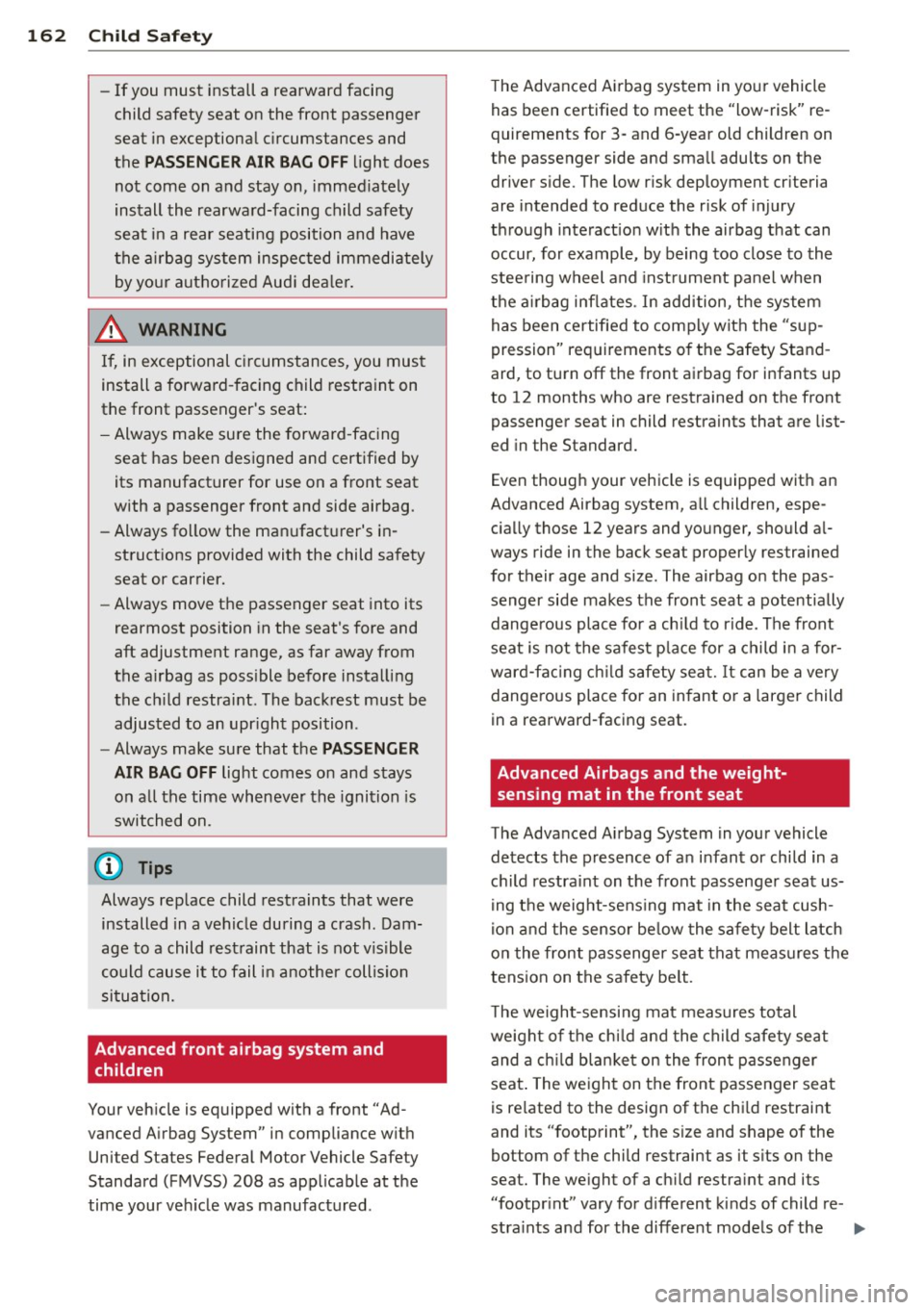
162 Child Safety
-If you must install a rearward facing
child safety seat on the front passenger
seat in exceptional circumstances and
the
PASSENGER AIR BAG OFF light does
not come on and stay on, immediately
install the rearward-facing child safety
seat in a rear seating position and have
the airbag system inspected immediately
by your authorized Audi dealer.
.&, WARNING
If, in exceptional circumstances, you must
install a forward-facing child restraint on
the front passenger's seat:
- Always make sure the forward-facing
seat has been designed and certified by
its manufacturer for use on a front seat
with a passenger front and side airbag.
- Always follow the manufacturer's in
structions provided with the child safety
seat or carrier.
- Always move the passenger seat into its
rearmost position in the seat's fore and
aft adjustment range, as far away from
the airbag as possible before installing
the child restraint. The backrest must be adjusted to an upright position .
- Always make sure that the
PASSENGER
AIR BAG OFF
light comes on and stays
on all the time whenever the ignition is
switched on.
(D Tips
Always replace child restraints that were
installed in a vehicle during a crash. Dam
age to a child restraint that is not visible
could cause it to fail in another collision
situation.
Advanced front airbag system and children
Your vehicle is equipped with a front "Ad
vanced Airbag System" in compliance with
United States Federal Motor Vehicle Safety
Standard (FMVSS) 208 as applicable at the
time your vehicle was manufactured . The
Advanced Airbag system in your vehicle
has been certified to meet the "low-risk" re
quirements for 3- and 6-year old children on
the passenger side and small adults on the driver side. The low risk deployment criteria
are intended to reduce the risk of injury
through interaction with the airbag that can
occur, for example, by being too close to the
steering wheel and instrument panel when
the airbag inflates . In addition, the system
has been certified to comply with the "sup
pression" requirements of the Safety Stand
ard, to turn off the front airbag for infants up
to 12 months who are restrained on the front
passenger seat in child restraints that are list
ed in the Standard.
Even though your vehicle is equipped with an
Advanced Airbag system, all children, espe
cially those 12 years and younger, should al
ways ride in the back seat properly restrained
for their age and size. The airbag on the pas
senger side makes the front seat a potentially
dangerous place for a child to ride . The front
seat is not the safest place for a child in a for
ward-facing child safety seat.
It can be a very
dangerous place for an infant or a larger child
in a rearward-facing seat.
Advanced Airbags and the weight
sensing mat in the front seat
The Advanced Airbag System in your vehicle detects the presence of an infant or child in a
child restraint on the front passenger seat us
ing the weight-sensing mat in the seat cush
ion and the sensor below the safety belt latch
on the front passenger seat that measures the
tension on the safety belt.
The weight-sensing mat measures total
weight of the child and the child safety seat
and a child blanket on the front passenger
seat. The weight on the front passenger seat
is related to the design of the child restraint
and its "footprint", the size and shape of the
bottom of the child restraint as it sits on the
seat. The weight of a child restraint and its "footprint" vary for different kinds of child re -
straints and for the different models of the .,.